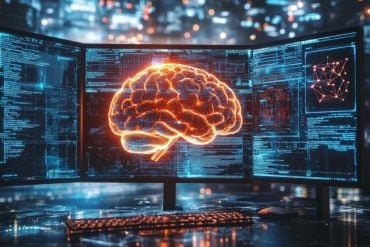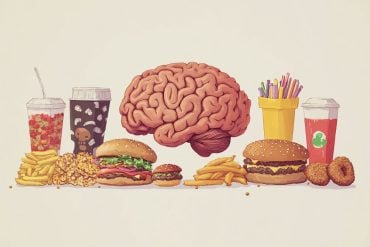Summary: A new study reveals newborns who are stressed by their environment have a greater neural pain response following a routine skin lance than babies who are not stressed. However, the neural response is not matched by their physical reaction to pain.
Source: UCL.
In stressed newborn babies, behaviour alone is not a reliable way of assessing pain, according to new UCL and UCLH research.
The study, published today in Current Biology and funded by the Medical Research Council UK, found that hospitalised newborns, who are already stressed by their environment have a much larger pain response in their brain following a routine clinical skin lance than non-stressed babies. But this is not matched by an equivalent increase in their pain behaviour.
This disconnect between the behaviour of newborn babies under stress and their brain activity in response to pain has not been shown before and suggests that stress is an important factor in influencing how babies perceive and react to pain.
“We see that an increase in pain related brain activity in hospitalised babies is not always accompanied by an increase in typical pain behaviour, such as body movement and facial expressions. This leads us to question the use of behaviour alone as a way of assessing infant pain, especially in a stressful environment. In adults, stress can increase pain experience and our findings suggest that this is also true for babies,” explained study lead, Dr Laura Jones (UCL Neuroscience, Physiology & Pharmacology).
“We know that repeated painful and stressful experiences in early life can negatively impact on the development of the central nervous system and our results suggest that controlling the stress levels of hospitalised infants may not only reduce their pain but also contribute to their healthy development.”
Researchers simultaneously measured the behaviour and brain activity of 56 newborn babies before and after a clinically necessary heel prick in their first days of life, while also monitoring their stress.
In the babies with the lowest stress levels, brain activity and behaviour were associated with each other in that greater brain activity corresponded to a longer period of crying and/or grimacing. In the babies with the highest stress levels this association was broken: greater brain activity was not necessarily matched by a more marked behavioural response.
“These results are important for people who care for newborn babies. Behaviour such as crying or facial responses is widely used as a measurement of a baby’s pain experience. Pain scores used for babies are based on these observations, because babies can’t speak. While these methods are very useful, our findings suggest that they may not be appropriate for babies who are already stressed. We need to explore better ways to monitor pain, reduce stress and tailor our interventions accordingly,” added co-author, Dr Judith Meek (University College London Hospitals NHS Foundation Trust).
The researchers measured the background level of stress in the babies using two approaches – heart rate variability and the level of cortisol in saliva. Each baby had a different level of stress due to natural variability in the population and their environments prior to the test.

During the test, brain wave patterns were tracked using electroencephalography (EEG) and behavioural changes, including facial expressions, and physiological changes were scored using a standard method called the premature infant pain profile (PIPP).
Two thirds of infants show a characteristic brain wave pattern for pain and a similar proportion display typical pain behaviour and a moderate pain score. The results show that the amplitude of the pain evoked brain waves was greater in babies with high stress compared to those with low stress.
“This work arose from a collaboration between scientists and clinical investigators. Our basic laboratory studies in the biology of pain processing in the developing nervous system have led to new discoveries about the formation of pain connections in the human infant brain. In the future, we plan to explore other environmental factors, such as maternal interactions, that may influence how our brains process pain at the beginning of our lives,” added Professor Maria Fitzgerald, co-author and head of the UCL research group.
Funding: The work was performed at the UCL department of Neuroscience, Physiology and Pharmacology and at the UCLH Neonatal Units.
Source: Bex Caygill – UCL
Publisher: Organized by NeuroscienceNews.com.
Image Source: NeuroscienceNews.com image is adapted from UCL news release.
Original Research: Full open access research for “Nociceptive Cortical Activity Is Dissociated from Nociceptive Behavior in Newborn Human Infants under Stress” by Laura Jones, Lorenzo Fabrizi, Maria Laudiano-Dray, Kimberley Whitehead, Judith Meek, Madeleine Verriotis, and Maria Fitzgerald in Current Biology. Published online November 30 2017 doi:10.1016/j.cub.2017.10.063
[cbtabs][cbtab title=”MLA”]UCL “Behavior Not Indicative of Pain in Stressed Babies.” NeuroscienceNews. NeuroscienceNews, 30 November 2017.
<https://neurosciencenews.com/pain-stress-babies-8071/>.[/cbtab][cbtab title=”APA”]UCL (2017, November 30). Behavior Not Indicative of Pain in Stressed Babies. NeuroscienceNews. Retrieved November 30, 2017 from https://neurosciencenews.com/pain-stress-babies-8071/[/cbtab][cbtab title=”Chicago”]UCL “Behavior Not Indicative of Pain in Stressed Babies.” https://neurosciencenews.com/pain-stress-babies-8071/ (accessed November 30, 2017).[/cbtab][/cbtabs]
Abstract
Nociceptive Cortical Activity Is Dissociated from Nociceptive Behavior in Newborn Human Infants under Stress
Highlights
•Infant pain behavior and nociceptive brain activity are generally correlated
•Stress disrupts the relationship between infant pain brain activity and behavior
•Stress is associated with increased nociceptive brain activity, but not behavior
•Stress is an important factor when assessing infant pain experience
Summary
Newborn infants display strong nociceptive behavior in response to tissue damaging stimuli, and this is accompanied by nociceptive activity generated in subcortical and cortical areas of the brain. In the absence of verbal report, these nociceptive responses are used as measures of pain sensation in newborn humans, as they are in animals. However, many infants are raised in a physiologically stressful environment, and little is known about the effect of background levels of stress upon their pain responses. In adults, acute physiological stress causes hyperalgesia, and increased background stress increases pain, but these data cannot necessarily be extrapolated to infants. Here we have simultaneously measured nociceptive behavior, brain activity, and levels of physiological stress in a sample of 56 newborn human infants aged 36–42 weeks. Salivary cortisol (hypothalamic pituitary axis), heart rate variability (sympathetic adrenal medullary system), EEG event-related potentials (nociceptive cortical activity), and facial expression (behavior) were acquired in individual infants following a clinically required heel lance. We show that infants with higher levels of stress exhibit larger amplitude cortical nociceptive responses, but this is not reflected in their behavior. Furthermore, while nociceptive behavior and cortical activity are normally correlated, this relationship is disrupted in infants with high levels of physiological stress. Brain activity evoked by noxious stimulation is therefore enhanced by stress, but this cannot be deduced from observation of pain behavior. This may be important in the prevention of adverse effects of early repetitive pain on brain development.
“Nociceptive Cortical Activity Is Dissociated from Nociceptive Behavior in Newborn Human Infants under Stress” by Laura Jones, Lorenzo Fabrizi, Maria Laudiano-Dray, Kimberley Whitehead, Judith Meek, Madeleine Verriotis, and Maria Fitzgerald in Current Biology. Published online November 30 2017 doi:10.1016/j.cub.2017.10.063






